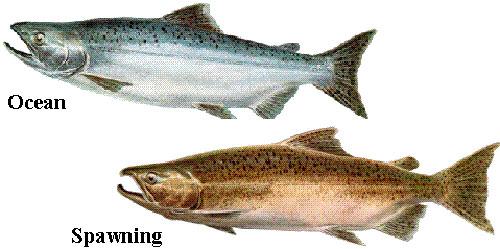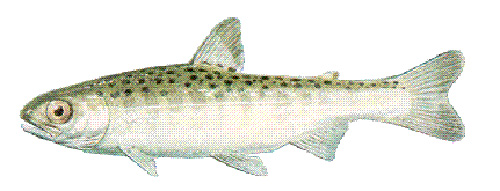|
Fish Factor Finding clues to Alaska's Chinook Salmon DeclineBy LAINE WELCH August 25, 2014
The ambitious effort marks the start of a state-backed five year, $30 million Chinook Salmon Research Initiative that includes 12 major river systems from Southeast Alaska to the Yukon. And while it will be years before the project yields definitive data, the scientists have pinned down some early findings. “It’s not the fresh water production of the juvenile Chinook that is the reason this decline is occurring, it’s being driven by poor marine survival,” said Ed Jones, the lead for the Initiative and Sport Fish Coordinator for the Alaska Dept. of Fish and Game.
Pictured: Adult Chinook salmon
At each river system, the Chinook team is estimating how many young fish are going to the ocean, refining estimates of how many older fish are returning to spawn, and tracking the marine catches. “That’s an effort to estimate the harvests of these 12 indicator stocks in detail,” he explained. “So we’re going to implement tagging programs on the juveniles and as they go out to the ocean they’ll be marked with an adipose fin clip. We also will include a tiny coded wire tag in their heads and those will be sent to the Juneau lab where we can tell when and where those fish were released. With those three components we can do full stock reconstruction.” Jones said his primary focus is on the Kuskokwim and Yukon Rivers because of the importance of Chinook salmon to subsistence users. “A major part of this initiative is to make sure we can help those folks fish when there’s fish around and pull the reins back when they are not around. But we need to gather the information that allows us to do that accurately each and every year. We are trying to learn from the users and gather information on historical harvests, what the people know and what they’ve learned for centuries. We’ll feed that information into our stock assessment program,” he said. Chinook salmon spend up to five years in the ocean and production goes through up and down cycles. A few years ago, west coast and British Columbia stocks were said to be doomed – but they have rebounded and are at record numbers in some cases. Jones believes that’s what will also occur in Alaska. “The take home message is that productivity cycles and unfortunately in Alaska right now, we are at the low end of that cycle”,” he said. “We are experiencing a tough time right now, but it will turn around so don’t lose hope.”
Smolt Stage
The first installment of disaster relief money will soon be on its way to Alaska fishermen hurt by low Chinook salmon returns to the Yukon, Kuskokwim and Cook Inlet regions. Disasters were declared by Governor Parnell for those three regions in 2012, opening the door for relief payments from the feds. NOAA Fisheries announced last week that $7.8 million will be distributed in direct payments to fishermen for their losses. The payments break out at $3.2 million for the Yukon-Kuskokwim Region and $4.6 million for the Cook Inlet Region. The checks will be administered by the Pacific States Marine Fishery Commission, and according to Senator Begich’s office, should be in the mail in September or October. More money will follow -- Alaska’s Chinook Salmon Fishery Disaster Relief Program netted nearly $21 million out of $75 million approved by Congress for fisheries in six US regions. NOAA said the remaining funds for Alaska of about $13 million will be based on a second grant proposal that the Pacific Commission is developing using spending plans by groups identified by the State and Alaska’s Congressional Delegation. Fraser River update Prices for Fraser River sockeye salmon are on a downward slope as managers continue to call for a strong run. The first fish a few weeks ago fetched starting prices at C$1.75-$1.85 per pound, and then dipped to C$1.65 (US$1.50). British Columbia’s Fraser River Panel said the early summer run topped two million sockeye; they estimated the so called summer run at 6.3 million reds through August 20th. The bulk of the Fraser run usually occurs at the end of August and no one is making any calls on that yet. Some are predicting a total catch of 10 million Fraser sockeyes, but that remains to be seen. Last week a coalition of Alaskans and some of the state’s largest fishing groups joined with the Congressional delegation to urge Secretary of State John Kerry to intervene with Canada as five large scale mines prepare to go on line in watersheds that feed into Southeast Alaska’s most productive salmon rivers. The five mines are part of a larger mineral development push by B.C. Premier Christy Clark who has pledged to create eight new mines and expand nine more by next year. Alaskans are citing the Boundary Waters Treaty between the US and Canada which states that trans-boundary waters “shall not be polluted on either side to the injury of health or property on the other side.” “Using that Treaty might get the Canadians’ attention. At least it would start the conversation,” said Brian Lynch, director of the Petersburg Vessel Owners Association. The state of Alaska has made no statements on either the Aug. 4 Mount Polley mining disaster or the threats the new BC mines pose to Southeast waters. Alaska’s major seafood companies are calling for a ban on Russian seafood exports to the US, and are seeking support from the Alaska congressional delegation and the US Trade Representative. The food ban resulted from trade sanctions imposed on Russia by the US and several other nations due to its aggressive actions in the Ukraine. The proposed embargo would remain in effect until Russia rescinds its year-long ban on U.S. foods, and also includes mechanisms to prohibit all seafood imports of Russian origin to the US, including Russian-caught seafood that is transferred through other countries before reaching this country. Hundreds of millions of dollars of Russian seafood imports are sold in the U.S. every year, with much of it coming through China. "We did not start this fight, and we hope the Russians will call off their embargo. But a US ban will signal to President Putin that America will not sit idly by while Russia disregards international law and tries to coerce the world into ignoring its transgressions through retaliatory actions," said Terry Shaff, President & CEO of UniSea Inc. Those endorsing the ban include Alaska General Seafoods, Alyeska Seafoods, Icicle Seafoods, North Pacific Seafoods, Ocean Beauty Seafoods, Peter Pan Seafoods, Trident Seafoods, UniSea, Westward Seafoods, and Alaska Bering Sea Crabbers.
This year marks the 24th year for this weekly column that focuses on Alaska’s seafood industry. It began in 1991 in the Anchorage Daily News, and now appears in over 20 newspapers and web sites. A daily spin off – Fish Radio – airs weekdays on 30 radio stations in Alaska. My goal is to make all people aware of the economic, social and cultural importance of Alaska’s fishing industry to our state, the nation and the world. Laine Welch ©2014 www.alaskafishradio.com SitNews ©2014 Stories In The News Ketchikan, Alaska
|
||


